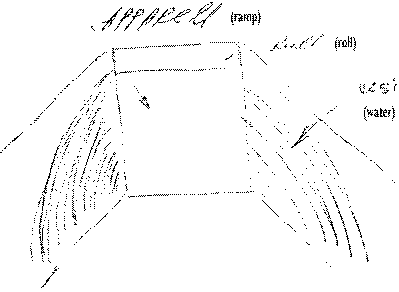1.29 No Stability with 2 000 tons of Water on the Car Deck - censored
The Final report (5) evidently states that the 'Estonia' heeled as a result of alleged water on the car deck in the superstructure (starting at 01.15 hrs). But the Final report does not mention that the 'Estonia', like all ferries under similar circumstances, should have turned turtle and floated upside down on the watertight hull after having reached an heel angle of about 34 degrees with 1 500-2 000 tons of water on the car deck, when the righting arm GZ was zero; 1.9, 1.15 and 2.16. Water (or any unsymmetrical, lose weight) on a watertight deck in a superstructure above the waterline cannot sink a ship - only tip it upside down. The deck house cannot prevent it.
The complete course of events, while water allegedly filled the car deck in the superstructure, is shamefully falsified in the Final report. Nowhere in the Final report is stated that water on top of the car deck in the superstructure cannot flow down into the hull below the car deck, from where the bilge pumps were taking suction - indicating leakage, as the openings in the watertight car deck in the centre line is always above the water when the ship is heeling (figure 1E in 2.16).
All stability calculations in the Final report are falsified.
1.30 The Bow Ramp was closed
The Final report states that the bow ramp was ripped off from its hooks and locks and was completely open and allowed a lot of water to enter the car deck. As evidence the Commission includes figure 6.1 on page 66 in the Final report (5), which shows a closed ramp, where water is leaking in at the edges - see below:
|
The sketch is done by crew member Henrik Sillaste and shows what he allegedly saw two minutes after the listing had occurred, when the 'Estonia' had already listed 20 degrees, i.e. the ramp was closed after the listing had occurred. The Final report does not explain why the ramp was closed at this time. The Final report does not even include proper drawings of the ramp and its locks and hooks. The upper two hooks had a breaking strength of 25-40 tons each and the four side locks about 25 tons each. The Final report states that the ramp was ripped open, but there is no evidence at all for this. When the wreck was filmed early October 1994 the ramp was evidently closed. Not one film shows an open ramp. |

Figure 1.30.1 - Figure 6.1 of (5) - Closed ramp at the forward end of the superstructure after listing |
All three witnesses in the ECR testified that the ramp never was open but closed, while water was leaking in around the frame - see chapter 6.2 in the Final report (5). Watch keeping AB Linde has stated that the ramp was closed at 01.30 hrs, when he was in a raft in the water outside the bow 1.8.
Divers apparently tried to open the ramp later 3.10.
If you ask Ms Ann-Louise Eksborg, director general of the Swedish SHK, when the ramp actually was open, she refuses to answer. Mr Kari Lehtola thinks 4.2 that the ramp closed itself by gravity, when the ship turned upside down, in spite of the fact that a large number of witnesses saw the ramp closed at about 01.30 hrs, when they had jumped into the water and when the list was <90 degrees. It is today (2001) a matter of faith to believe that the ramp was fully open - sometimes during the accident - even if there is no evidence at all for it. The reason is of course that Meister, Forssberg and Lehtola already on 17 October 1994 had stated that the ramp had been open 1.11 - the day before the visor was allegedly found - and that they did not want to change this fundamental lie later. It was an essential part of the falsification of History.
All statements in the Final report, that the ramp was ever pulled open, are false.
---